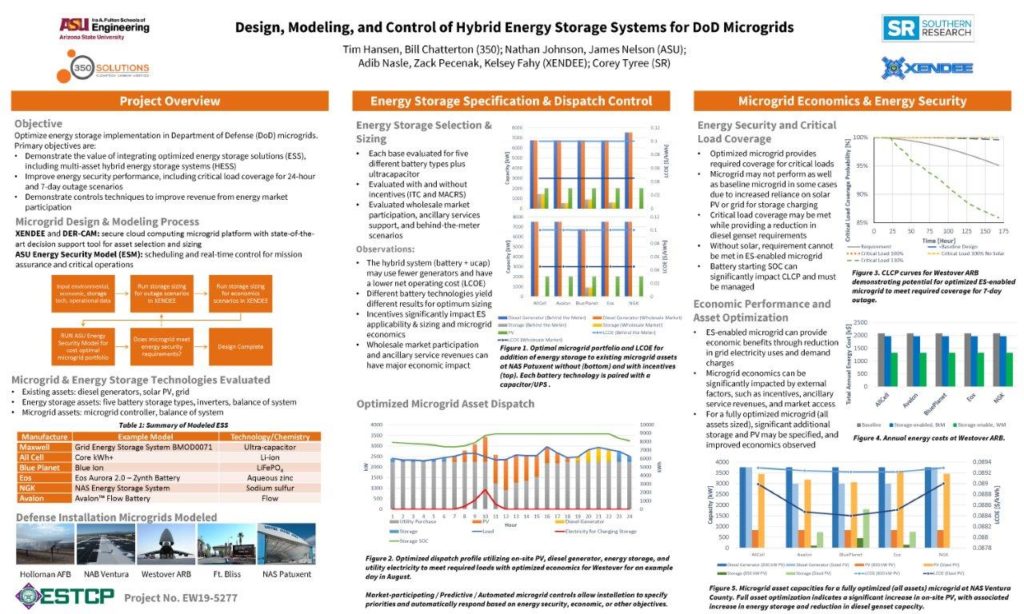Executive Perspective: 2019 SERDP – ESTCP Symposium in Retrospect
Earlier this month I attended the SERDP – ESTCP Symposium, an annual Department of Defense meeting focused on environmental and energy challenges the DoD is interested in addressing. It is always an informative event, with the sessions providing overall insight into challenges, priorities, and progress on key issues, while the technical and poster sessions provide deep insight into potential solutions.
I wanted to note a few key observations from the plenary and technical sessions regarding overall activity and priorities as well as some specific technical points related to our current ESTCP project.
- The work of SERDP and ESTCP has, for 25 years, helped to address significant challenges to DoD operations and budgets that have directly and indirectly impacted the DoD mission.
- The number of environmentally related challenges the DoD faces continues to grow, with executive orders, regulations, and other mandates being issued more frequently.
- Two major challenges currently faced by DoD and targeted as existing and future priorities are (1) PFAS replacement and remediation, and (2) resiliency.
- Resiliency is a growing issue, with new challenges developing that need unique response, planning, and capabilities developed. Challenges that impact resiliency are shifting and now include climate change and energy security – whether from weather impacts, physical attacks, cyberattacks, or other forces.
I think the last point is a good lead into some of the technical observations related to resiliency and the project we have been working on with Arizona State University and XENDEE. First, a few more observations from the technical session regarding resiliency – particularly focused on energy at domestic installations.
- Renewables and distributed generation and climate impacts such as storms and fires are all impacting the energy infrastructure at military bases, and driving the need for solutions that can alleviate their impact and take advantage of new strategies to ensure on-base security for critical loads.
- Technologies (energy storage, microgrids, renewables, and on-site generation) offer viable solutions the energy resilience challenges, with some requiring additional development and demonstration (Go ESTCP!) to ensure impacts are validated before investments are made.
- Economics are critical. Currently, without a specific value placed on resiliency, new technologies need to compete and demonstrate improved economics vs. current infrastructure (the grid). Period.
- Business models are becoming more and more critical because of this. Sure, we can add an energy storage technology and microgrid controller at a facility, but how does one structure a business around this, when the comparison is to cheap diesel generators and lead acid battery backup systems? Many approaches, but this is still shaking out.
- Nick Judson’s (Massachusetts Institute of Technology (MIT) Lincoln Laboratory), presentation on Findings from Energy Resilience Exercises, was eye opening. In addition to all of the above, simply maintaining what DoD has can provide a major boost in actual resiliency. And, you don’t know if what you have works as planned until you test it – in a full integrated system.
I joined Dr. Nathan Johnson from Arizona State University (ASU) to present a poster on our current ESTCP project: Design, Modeling, and Control of Hybrid Energy Storage Systems for DoD Microgrids, which we completed under Southern Research and 350Solutions along with ASU and XENDEE. The project demonstrated a microgrid and energy storage modeling and design platform, with integrated analytics and controls capability, to provide cost and energy security optimized microgrid designs and controls strategies for five DoD installations. We looked at six different types of energy storage technologies: lithium ion, lithium ferrous phosphate, vanadium redox flow, sodium sulfur, and zinc hybrid cathode batteries, combined with ultracapacitors. We also looked at the impact of allowing microgrid participation in markets as well as implications of incentives on system design and economic performance.
At the end of the day, there are a few critical observations from our work.
- Modeled energy storage microgrid systems, including a hybrid system using a battery and ultracapacitor, use fewer generators and have a lower net operating cost.
- Incentives (i.e. investment tax credits) make a big difference and could potentially be accessed through the addition of energy storage as part of solar PV projects.
- Using on-site microgrid assets to manage demand charges or other ‘behind-the-meter’ costs can impact system economics. However, enabling ‘front-of-the meter’ wholesale electricity market participation and providing grid ancillary services (i.e. frequency regulation or reserve) can change the economics dramatically.
- Different batteries yield different results on optimum system sizing. But, in many cases, economics end up being so close that choice of battery tech will likely end up being based on the technology pricing of the day.
- Storage and asset management has to be well planned and managed to ensure that when islanding begins, the battery starting SOC and solar PV variability don’t hinder resilience.
Ultimately, we think our research demonstrated that these systems are viable and microgrids can be a game changer in terms on resiliency and economics. HOWEVER, they must be designed and managed properly, and in cooperation with utilities, to enable additional value from market participation and ancillary services.
We hope to be working with ESTCP to move toward hardware in the loop (HIL) testing of the optimized energy-storage-enabled microgrid designs and control strategies we modeled in this Phase I program. That will give us and DoD the validation that not only do system design and technoeconomics pan out, they can actually be implemented, controlled, and managed to meet the modeled targets. If THAT holds true, a field demonstration and broad deployment could be next, providing potential economic value and critical resilience needs for DoD installations globally. We are looking forward to working with our partners to meet this challenge!
If you would like the detailed numbers on our research, beyond what is featured on the poster board below, we will have the summary available soon, and link it on our site.
Tim Hansen, Founder & CEO, 350Solutions

